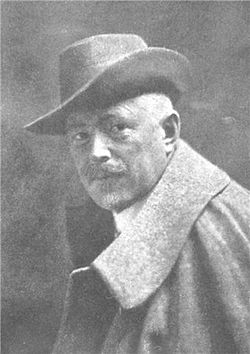Top Qs
Timeline
Chat
Perspective
Władysław Horodecki
Russian-born Polish architect (1863–1930) From Wikipedia, the free encyclopedia
Remove ads
Władysław Horodecki (born Leszek Dezydery Horodecki; Russian: Владислав Владиславович Городецкий; Ukrainian: Владислав Владиславович Городецький; June 4 [O.S. May 23] 1863 – January 3, 1930) was a Polish architect[1] active in the Russian Empire and later in the Second Polish Republic. He is best known for his contributions in the urban development of Kyiv, with buildings such as the House with Chimaeras, the St. Nicholas Roman Catholic Cathedral, the Karaite Kenesa, and the National Art Museum of Ukraine.[2]
In Kyiv, Horodecki often worked along with a sculptor from Milan, Emilio Sala, who was an instructor at the Kyiv City College.[citation needed]
Remove ads
Life and career
Summarize
Perspective

Russian Empire
Horodecki was born into a noble Polish szlachta family of the Kornic coat of arms in the village of Szołudki (Sholudky, now Mukhivtsi Rural Council, Nemyriv Raion, Vinnytsia Oblast, Ukraine). His ancestors were big landowners in the Podillia region. Horodecki graduated from the Imperial Academy of Arts in St. Petersburg in 1890, while prior to that he finished a realschule in Odesa. After 1890, Horodecki moved to Kyiv, where he lived for almost 30 years.[2]
Poland
As Poland regained its independence after the Polish-Soviet War in 1920, and Russia, including Kyiv, fell under Bolshevism, he emigrated to Warsaw. In Poland, Horodecki headed an American Project Bureau, "Henry Ulan & Co." Some of his designs were built including a water tower and trade rows in Piotrków Trybunalski (today in Lodz Voivodeship), a meat factory in Lublin, a bath house in Zgierz, and a casino building in Otwock.[3]
Persia

In 1928, on the invitation of the same company, Horodecki moved to Tehran, becoming a chief architect of the Syndicate on the Design of Persian Railways. He designed in particular the building of the Tehran railway station. In 1930 he died and was buried at Doulab Catholic Cemetery in Tehran. His epitaph is inscribed in Polish with only the phrase Profesor architektury. Niech mu obca ziemia będzie lekka., which translates into English as "Professor of architecture. Let the foreign earth be light for him."
Remove ads
Remembrance
One of Kyiv's streets, designed by Horodecki,[4] (between Maidan Nezalezhnosti and House with Chimaeras) was named after him in 1996 as vulytsia Arkhitektora Horodetskoho. The street had been called ulitsa Nikolayevskaya, and in Soviet times it was known as vulytsia Karla Marksa, after Karl Marx.
In 2004, a statue honouring Horodecki was unveiled in Kyiv at 15 Khreshchatyk.[5]
In 2011, Horodecki's bust made of white marble was unveiled in the town of Nemyriv, close to the architect's birthplace in Szołudki. The monument features Horodecki's name as well as his years of birth and death.[6]
In 2013, a 5-hryvnia commemorative coin depicting Horodecki was issued in Ukraine on the 150 anniversary of the architect's birth.[6]
Remove ads
Works
- Vyshnivets Palace (reconstructed by Horodecki)
- Otwock casino
See also
References
External links
Wikiwand - on
Seamless Wikipedia browsing. On steroids.
Remove ads








